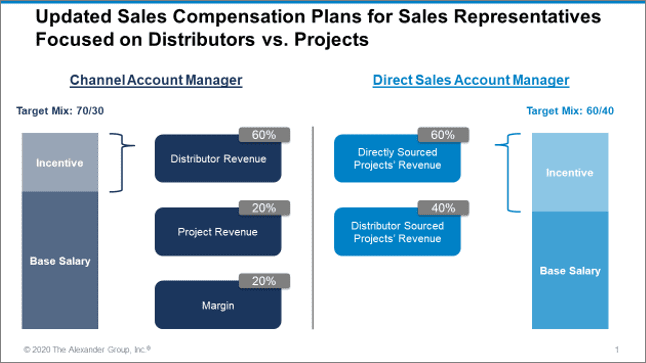Revise Roles & Sales Comp Plans to Drive Growth

Crediting rules in sales compensation are used to determine which role or roles receive a cut of a sale.
Crediting challenges arise when there is a perception of limited resources to share. An example of this occurs in sales organizations when channel account managers (CAMs) and direct sales account managers (AMs) compete to sell to the same customer without collaboration or alignment. This results in wasted effort, lost productivity, internal sales force distrust and an overall negative customer experience. To avoid these damaging effects, manufacturers should clarify sales roles and design more effective sales compensation plans to expand opportunities for both AMs and CAMs.
Alexander Group recently worked with an industrial products manufacturer that historically sold through distributors using CAMs. The CAM sales compensation plan incented total sales and margin. The company recently added an AM role to sell large projects directly to end customers. The goal of the AM was to drive additional revenue by hunting for leads and managing end-customer relationships more closely. While the AM sales compensation plan incented large project sales, it did not allow these sales to provide credit towards retiring a CAM’s sales quota, even though existing distributors would fulfil such projects.
CAM and AM Conflict
As expected, these decisions led to unhealthy competition between the two roles. CAMs tried to steer distributors away from supporting any projects sold directly by the company. The AMs, on the other hand, tried to convince distributors to convert more sales opportunities into large projects that were best suited to their goals. AMs began to rely on distributors for project leads given the ease of sourcing such leads vs. hunting for leads.
This conflict resulted in two sales roles calling on the same distributors. Moving from a single point of contact to multiple interactions caused a drop in distributor satisfaction. The sales role design, sales compensation plans and sales management were failing the company’s goal of additional revenue growth.
The Solution: Revise Sales Roles and Rules of Engagement
Working with Alexander Group, the company identified that the sales compensation plan design did not align with company goals. However, during the executive and field sales interviews, Alexander Group quickly realized that the company also needed to update the sales roles and rules of engagement.
First, Alexander Group clearly delineated CAM and AM roles and responsibilities, including the rules of engagement with each other, distributors and end customers. CAMs would be the single point of contact for distributors. AMs would work through the CAMs to pursue project opportunities with the distributors. Additionally, AMs would start identifying the majority of leads independently to reduce reliance on distributors.
Next, Alexander Group developed sales compensation plans that reinforced the above behaviors. Distributor revenue was the primary measure in the CAM plan reflecting their main responsibility of driving sales through distributors. In addition, the CAM plan included project revenue (sold by AM) as a separate measure to ensure CAMs supported such sales. For the AMs, the sales compensation plan included two measures: directly sourced revenue and distributor sourced revenue. This would ensure AMs would not solely rely on distributors for opportunities. In general, best practice dictates to not double credit two sales representatives on the same sale if an account or opportunity is not reflected in both of their quotas. However, it made sense in this situation. Better resource collaboration, reduced internal conflict, enhanced sales representative productivity and increased distributor satisfaction offset the extra commission costs.

Summary and Considerations
After rolling out the new plans, feedback from the sales team was quite positive. The company saw success with significantly reduced conflict and attrition. Distributor sales and project sales were up at rates higher than the previous year.
Have you noticed any challenges between your channel team and direct sales team?
Alexander Group can help. For more information, please contact an Alexander Group Manufacturing Practice Leader.